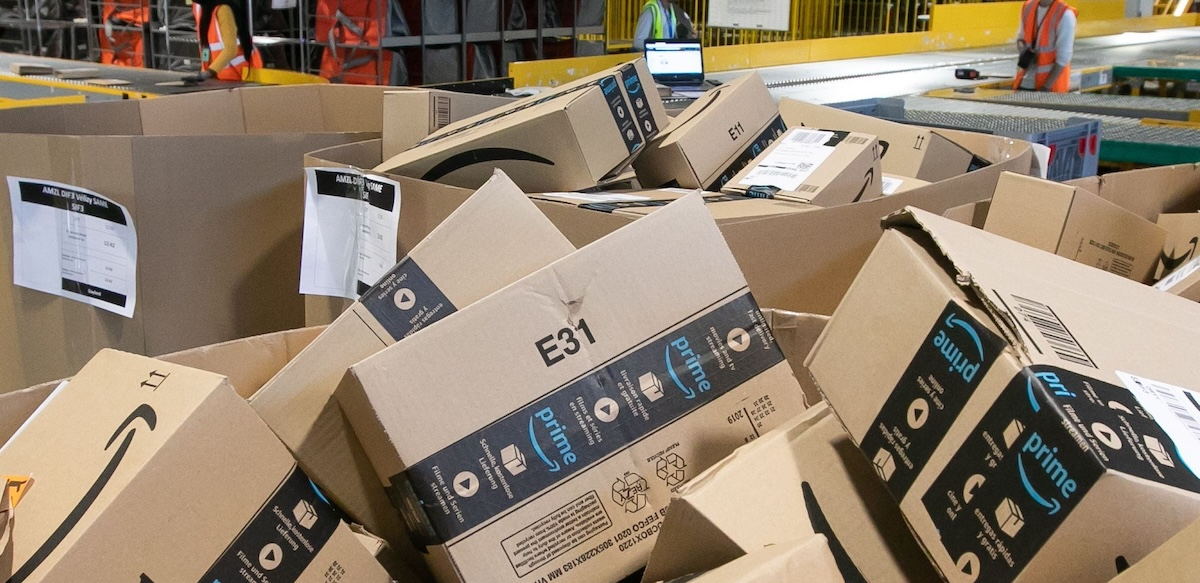Amazon Workers Defy Dictates of Automation

Automation at Amazon’s delivery station in Maspeth, Queens has led to box pile-ups and speed-up for remaining workers. Photo: Romuald Meigneux/SIPA
Amazon delivery stations are being outfitted with robots across the country, leading to fewer workers and speedup for the workers that remain. Workers have reacted with defiance at the delivery station where I work.
Amazon fulfillment centers, where items are packaged up, have been gradually automating, but until now, delivery stations were mostly operated by human labor. Now, entire systems are being retrofitted or entirely removed “in the name of safety” and “for the good of employees.” But automation means workers will be laid off, shifted into new positions, or forced to transfer.
I work at the New York delivery station DBK4, in Maspeth, Queens, and it’s a window into this future. Smack in the middle of New York’s largest borough, DBK4 processes 60,000 to 100,000 packages daily, depending on the season. It employs 200 to 500 people inside the warehouse, plus up to 1,000 drivers.
Amazon has recently automated 80 percent of the conveyor belts in the facility with a new type of technology called ADTA (Auto Divert to Aisle). Before automation, the job was done in two parts; a belt brought packages from the loading dock and ‘pickers’ standing along its length picked up the packages. The pickers put packages onto racks corresponding to neighborhoods. A second worker, known as a stower, often working multiple aisles, then put those packages into bags bound for specific neighborhood blocks.
REASSIGNED, SPEEDED UP
ADTA has changed all that. Pickers are being replaced, with most being reassigned as stowers. An intricately-designed belt now does their job, diverting the packages from the belt and into the aisles to be stowed.
Overall, sorting packages now requires fewer workers. But automation has also created new roles. For now, only the human touch can ensure the packages are lined up appropriately for the new belts. And the machine can only handle packages of smaller dimensions and weight without breaking down, so workers still have to deal with the larger packages.
FALSE CLAIMS OF SAFETY
Amazon’s public spin is that this automation makes warehouses safer. But it is apparent to me that the machines are not for our safety but to increase worker productivity. ADTA pushes packages much faster than humans do, causing downstream stowers to face growing piles of packages.
The result of the speedup is that DBK4 now processes more volume with fewer people, while dumping ever-bigger piles of packages onto a shrinking number of workers.
Safety has gone out the window as everyone moves according to the whims of ADTA. Workers must incessantly attend to an inhuman barrage of packages or risk having their aisles overflow with boxes. This in turn means workers are in danger of tripping over the overflowing boxes.
INCESSANT ALARMS
While workers struggle to keep up, the machines set off a piercing alarm that doesn’t stop until the piles of boxes are cleared. Now the alarms blare non-stop. Silence has become a thing of the past. So has any opportunity to catch my breath.

SUPPORT LABOR NOTES
BECOME A MONTHLY DONOR
Give $10 a month or more and get our "Fight the Boss, Build the Union" T-shirt.
As “outdated” roles disappear, so does work variety. Warehouse work is strenuous and every role uses a different set of muscles. As the variety of roles decreases, workers are forced to do the same movements all day every day. Since roles are determined by management and they always prioritize productivity, they assign workers to roles they have the “best numbers” on repeatedly.
Repetitive stress injuries will inevitably rise.
In addition to the new belt automation, DBK4 has been turned into a same-day facility. This new shop-floor role handles speedy delivery of items, getting them to customers within 24 hours.
My co-workers report feeling less and less valued and more and more overworked.
WORKERS REFUSE SPEED-UP
There is a silver lining. As Amazon pushes us harder, it creates organizing opportunities. People have already begun to fight back. Many workers have started working more slowly than the machine requires, leading the machines to break down mid-shift. The site falls behind on deliveries and has to roll over the work to the next day.
These individual acts of defiance have become routine at DBK4. Workers are angered by management’s inability to address their concerns, and that fuels daily antagonism toward the company.
I see it everyday. The ‘Voice of the Associate’ is a whiteboard where Amazon solicits employee feedback. Every day it is plastered with complaints about the new system and threats to abandon the worksite.
Almost everyone wears headphones to drown out the incessant alarms, leaving management frustrated as both machine and worker ignore their commands. These new circumstances have created a situation ripe for organizing that could finally be the chink in Amazon's armor as they push these machines out across their network.
Alvin Gaine is an Amazon warehouse worker at DB4K delivery station in Queens, New York.





